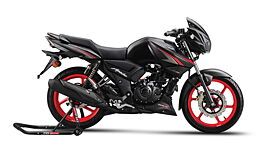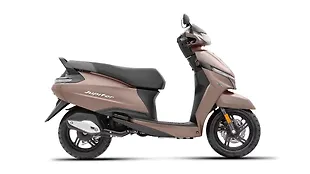Introduction

The sub-200cc performance motorcycle segment now has more choices than ever. We recently had two models from this segment, the TVS Apache RTR 160 (2V) and the Bajaj Pulsar P150, in the Bikewale garage and with their similar performance and prices, it was a no-brainer that a comparison road test was in order. The Apache RTR 160 has been a stepping stone for many performance enthusiasts into the segment while the Bajaj Pulsar brand has appealed to the more mature buyers.
Now, however, Bajaj Auto is bringing out motorcycles with modern design, and its new Pulsar P150 is among the list of products that are aimed at young buyers. So, which one should you buy? We explain it in this comparison road test review.
Design and Quality

The styling of the TVS Apache RTR 160 hasn’t changed much since it was first introduced. However, for 2023, the motorcycle gets a new headlight design along with LED lighting that brings this TVS Motor Company product at par with its rivals. Then, the cockpit gets an upgrade, and the Apache RTR 160 drops the semi-digital console with an analogue tachometer for a fully-digital unit on the 2023 model. Further, the range-topping version of this motorcycle benefits from Bluetooth connectivity and gets more information than the lower variants. In a bid to attract young buyers, TVS offers the Apache RTR 160 in five bold colours – all featuring sporty graphics.

The Bajaj Pulsar P150, on the other hand, gets a modern design that is inspired by the Pulsar N250 and the Pulsar N160. At the front, this Pulsar motorcycle gets a projector-style LED headlight with LED DRLs. Similar to the Apache RTR 160, the Pulsar P150, too, gets a body-coloured headlight cowl and a matching shade for the engine cowl. However, the Pulsar P150 comes with a split-style saddle with a much more friendly mechanism to access the under-seat storage.

The quality is equally good on both motorcycles. However, the TVS Apache RTR 160 with its fully-digital module and carbon-fibre textured design on body panels, comes across as a more premium and sporty package. Meanwhile, the colour palette is large for both bikes, with five paint options on each product. The styling is appealing too, but the Pulsar P150’s modern design has a slight advantage over its rival in this comparison. Does the ergonomics and comfort department say the same?
Ergonomics and Comfort

These two motorcycles have many similarities in terms of engine performance and fuel efficiency. More on that in the latter part of the review. But the ergonomics are what sets these motorcycles apart. The Apache RTR 160 has a noticeably tall position for the footpegs, and it feels somewhat cramped for my 5’10” height. Shorter riders, on the other hand, may find this rider’s triangle more comfortable. The Pulsar P150, in comparison, feels more natural, spacious, and comfortable. The common factor in terms of comfort is the seat padding that feels sufficiently firm without being too stiff, making long rides more relaxed. The seat itself is just 790mm tall on both motorcycles so reaching the ground with a flat foot is no challenge.

The suspension is on the plusher side for both motorcycles and they iron out the undulations very efficiently. The Pulsar P150, however, has a more modern setup with a mono-shock at the back. Whereas, the Apache RTR 160 still uses twin-sided rear springs to perform the shock absorption tasks. Now, this compromises the handling department and these motorcycles are not something that you would tag as canyon carvers. More on that in the performance and handling part of this road test review.
Features and Tech

The new Apache RTR 160 has received a major feature boost and the top variant of the 2023 model benefits from the TVS SmartXonnect Bluetooth module that brings along a plethora of information. This includes access to call/SMS alerts along with turn-by-turn navigation. It also has low fuel warning and assist function that redirects the rider towards the nearest fuel station. Then, the safety functions include a crash alert system that sends emergency information to predefined contacts. The instrument cluster shows additional information too. Apart from the regular data such as a tachometer, speedometer, odometer, two trip meters, fuel gauge, and a clock, the console also shows a lap timer, top speed recorder, 0-60kmph acceleration timer, and an average speed recorder.

The Pulsar P150 misses the Bluetooth module, and it doesn’t show as comprehensive data as the Apache RTR 160. But it has a USB charger that is conveniently located near the handlebar. While both motorcycles come with an LED headlight which delivers a promising performance, the projector setup on the Pulsar P150 is far more efficient at illuminating the road after dark than the Apache RTR 160. Thus, although the Apache RTR 160 has more features on paper, it’s the Pulsar P150 that is more practical among the two products.
Performance and Handling

The Apache RTR 160 has a slight edge over the Pulsar P150 in terms of numbers. The Apache RTR 160 uses a 159.7cc, single-cylinder, air-cooled engine. The Urban and Rain modes limit the power and torque outputs to 13.1bhp at 8,000rpm and 12.7Nm at 6,500rpm, respectively. Meanwhile, the Sport mode offers access to the full 15.8bhp at 8,750rpm and 13.85Nm at 7,000rpm. Now, these modes do not alter the engine character. Instead, the Urban and Rain modes limit the revs to 8,000rpm. This, in turn, limits the top speed of the Apache RTR 160 in the lower power modes. Thus, we used the Sport mode for almost the entire road test. Meanwhile, the Bajaj Pulsar P150 has no ride modes. The 149cc, single-cylinder, air-cooled motor on this Bajaj product makes 14.29bhp at 8,500rpm and 13.5Nm of peak torque at 6,000rpm.
While the Apache RTR 160 makes slightly more power and torque, both motorcycles are equally fast. Both vehicles maxed out at around 125kmph on the highway. The character is almost similar, too, but the Apache RTR 160 feels slightly peppier whereas the Pulsar P150 has a relatively linear power delivery. Both motorcycles feel comfortable above 3,000rpm, and they start to accelerate smoothly post 4,000rpm.

They can cruise at 80kmph at approximately 6,000rpm, while anything above 90kmph feels stressful. The five-speed gearbox feels nice as well and we did not face any shifting issues on either of them during the road test. The clutch on the Pulsar P150, however, is remarkably lighter and this enhances the comfort levels, especially in bumper-to-bumper traffic. It has a crisper gearbox too as compared to the Apache RTR 160. Then, the braking setup comprises disc brakes on both wheels and the setup on both bikes feels progressive. They feature single-channel ABS, however, TVS uses a fancier term and calls it Super Moto ABS.
The handling is decent, and it’s remarkably easy to filter through moving traffic. But the Pulsar P150 feels more comfortable thanks to the aforementioned ergonomic advantage over the Apache RTR 160. Also, the longer wheelbase makes the Pulsar P150 more stable at higher speeds while the Apache RTR 160 feels borderline twitchy at similar numbers on the speedometer. Then, although the tyres deliver a decent performance, the grip feels insufficient when pushing hard. Lastly, the turning radius is sufficiently short, but not as much as something like the Royal Enfield Hunter 350.
Conclusion

In the point comparison, the Pulsar P150 has a slight advantage over the Apache RTR 160 despite the additional features of the latter. It also reflects in our experience, and the Pulsar P150 does feel like a more desirable product among the two. It looks stylish, feels comfortable, and delivers what a typical buyer in the segment would probably want, especially a mature customer. The Apache RTR 160, on the other hand, would attract young buyers who want modern features at an affordable price tag. Check out the complete point comparison below:

Photography by Kapil Angane
Gallery
1/24
TVS Apache RTR 160 Right Front Three Quarter
Double Tap to Zoom









































![KTM 390 Adventure X [2025] KTM 390 Adventure X [2025]](https://imgd.aeplcdn.com/272x153/n/cw/ec/190885/390-adventure-x-2025-right-side-view.jpeg?isig=0&q=80)